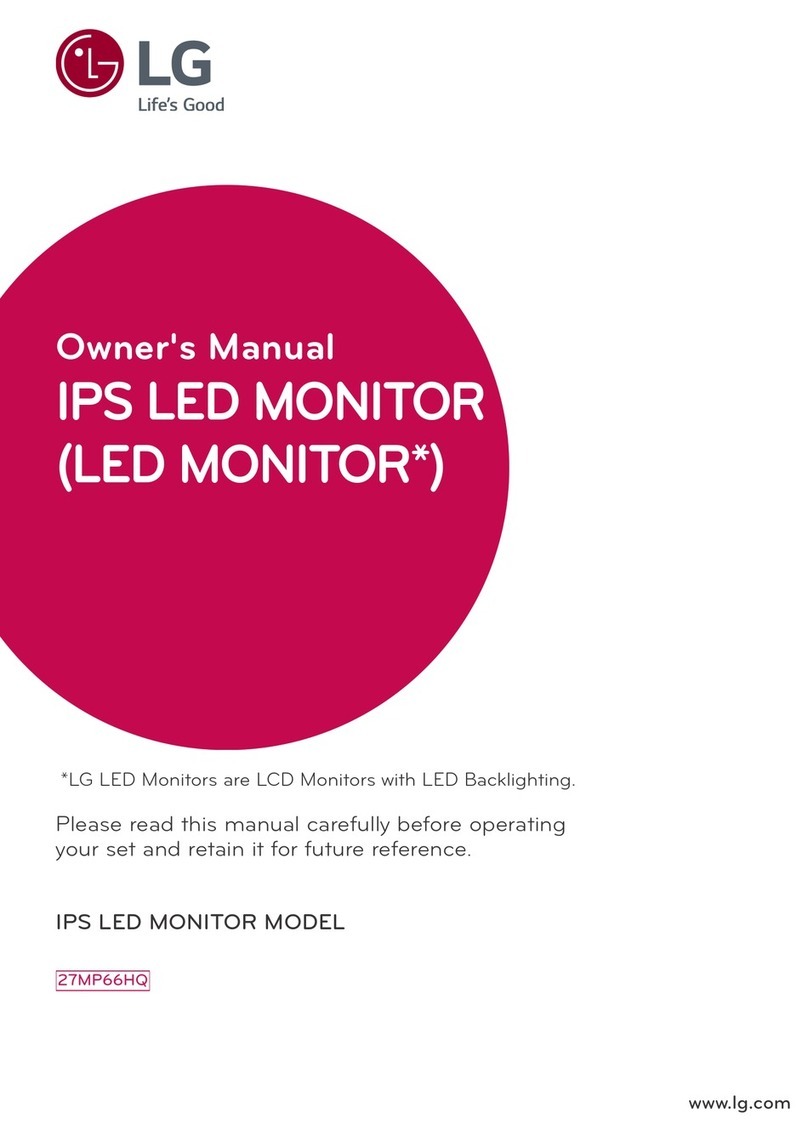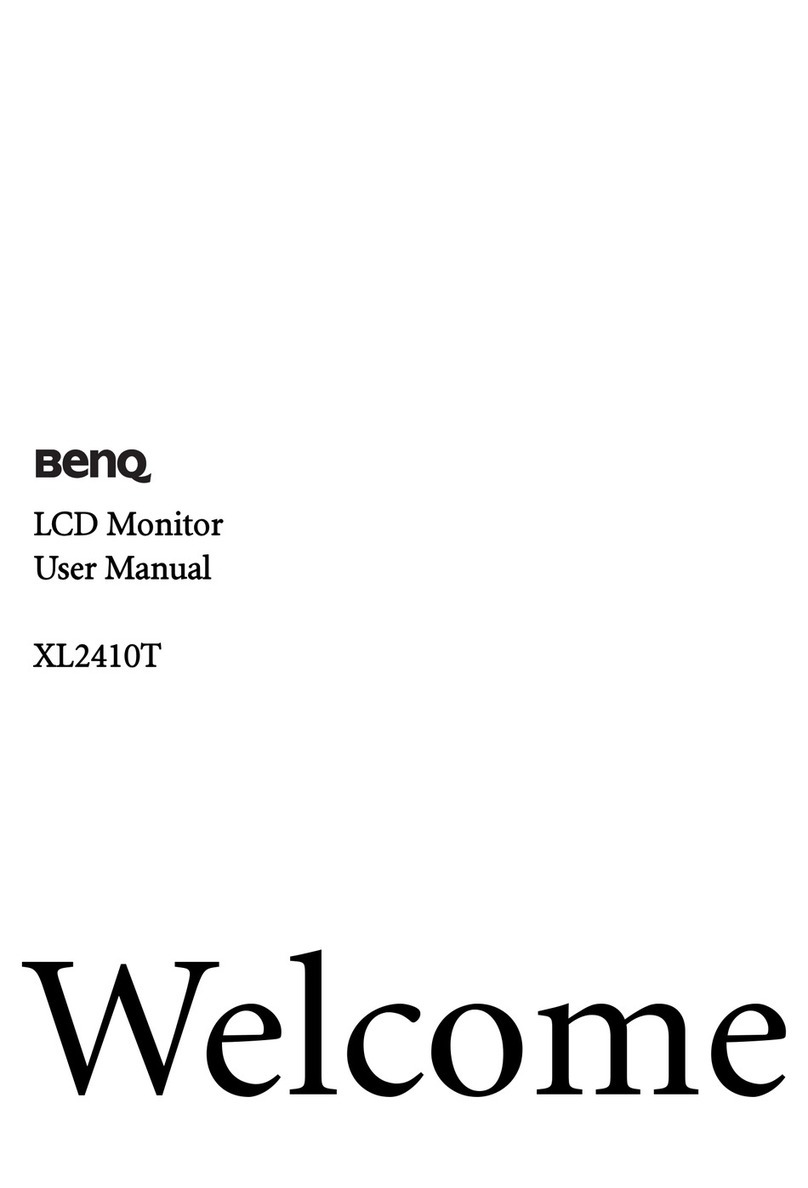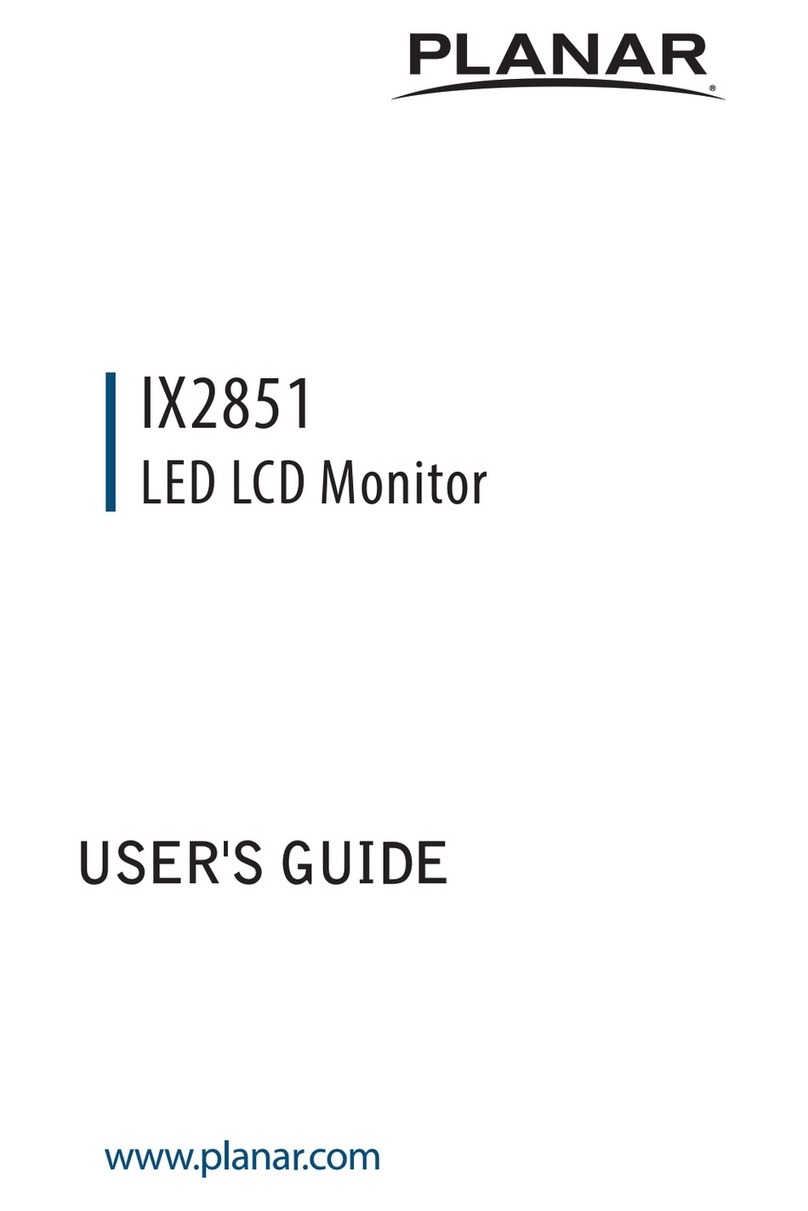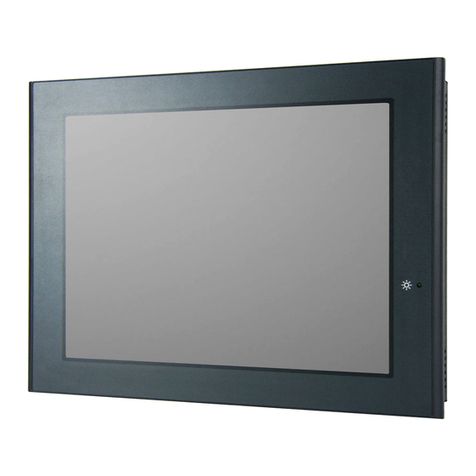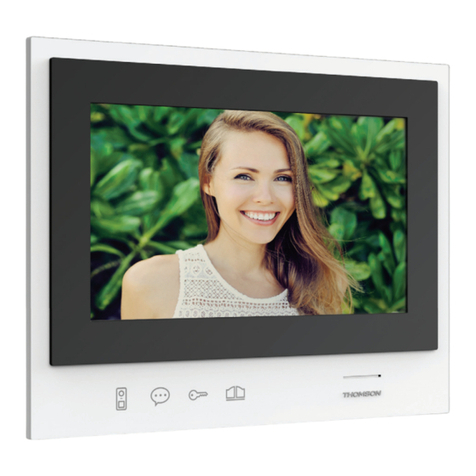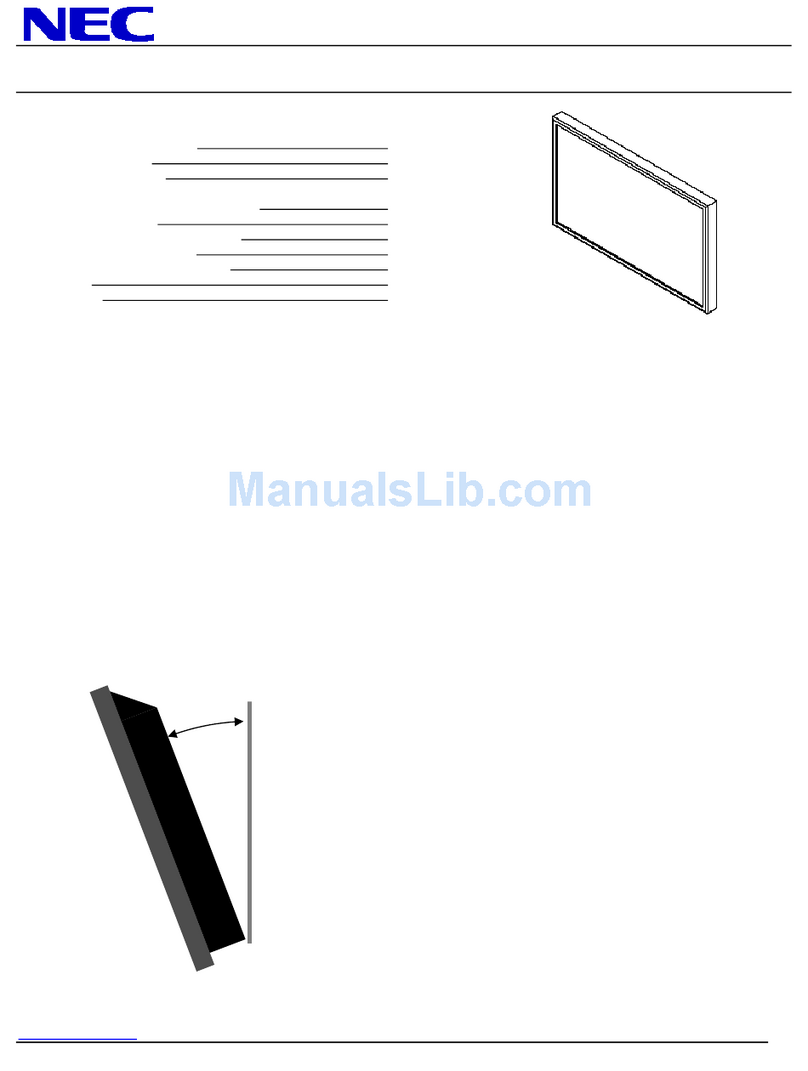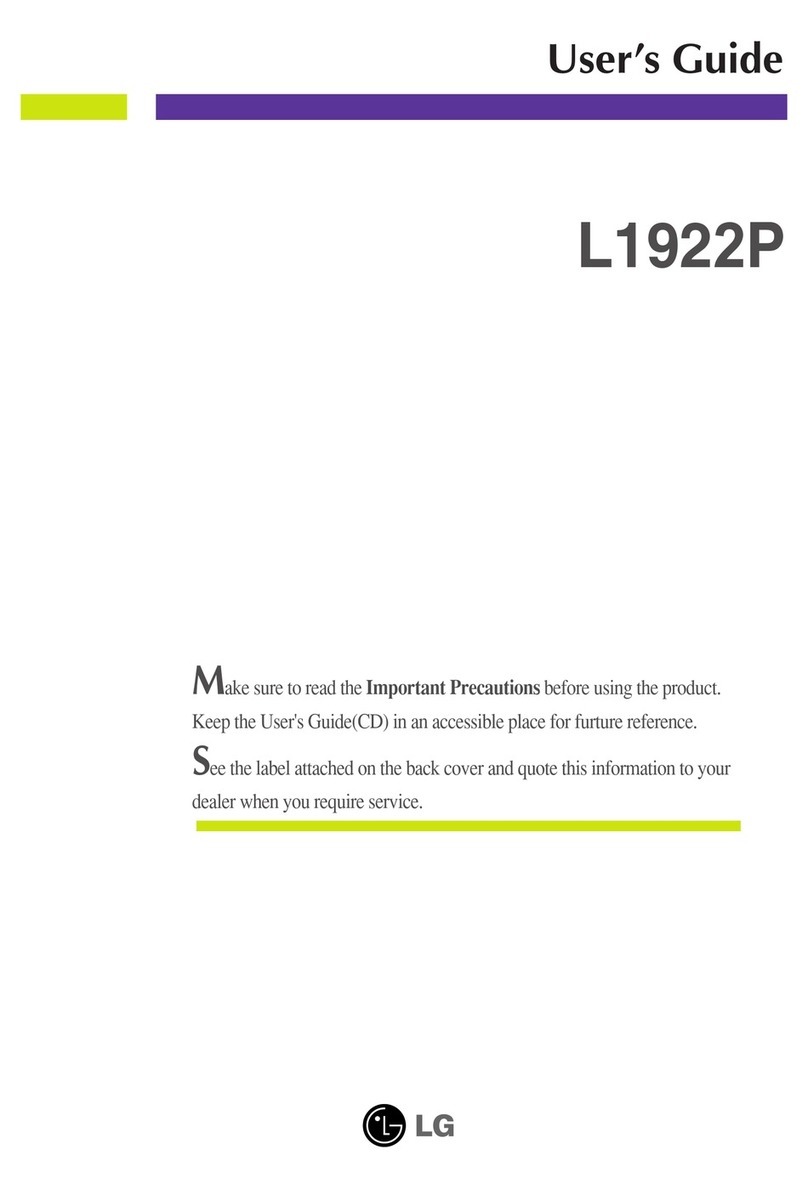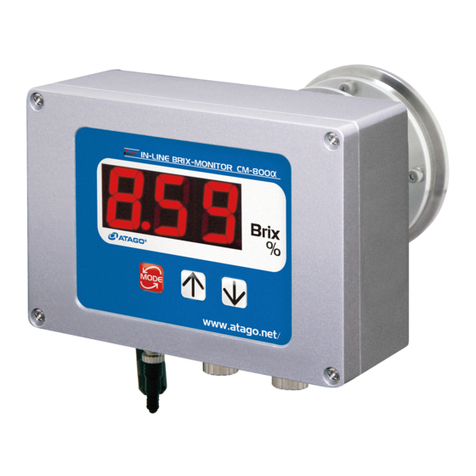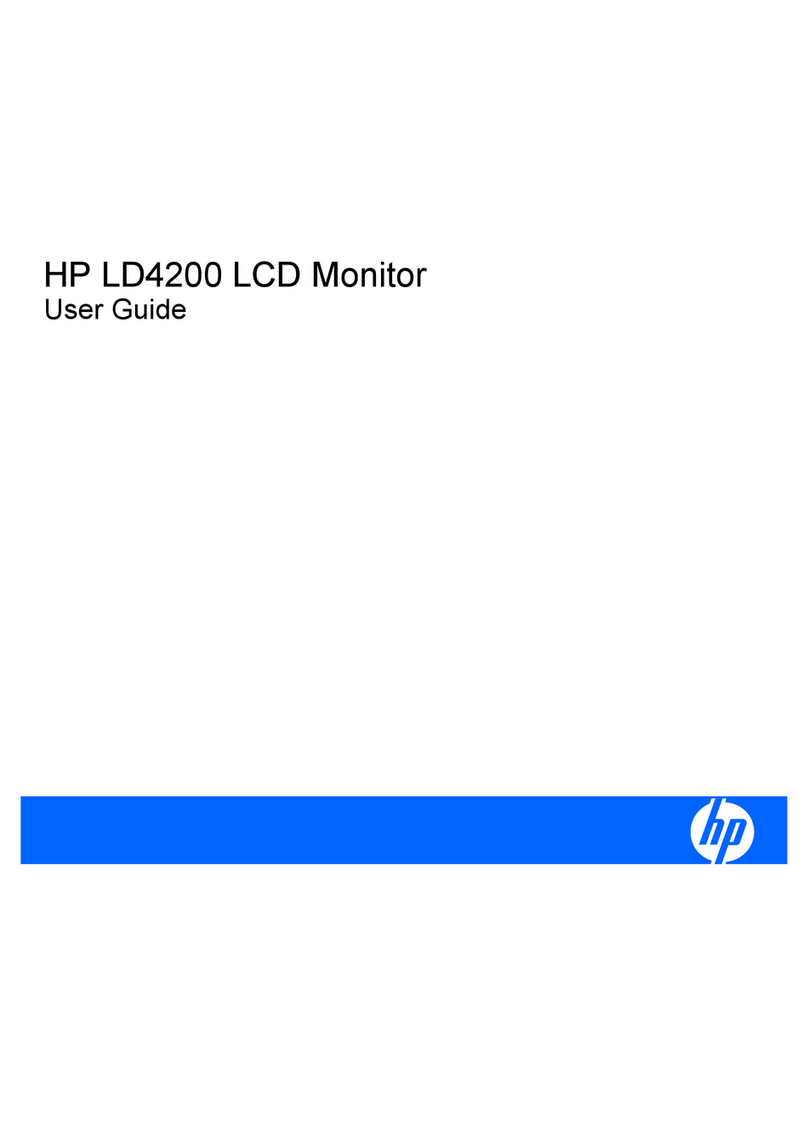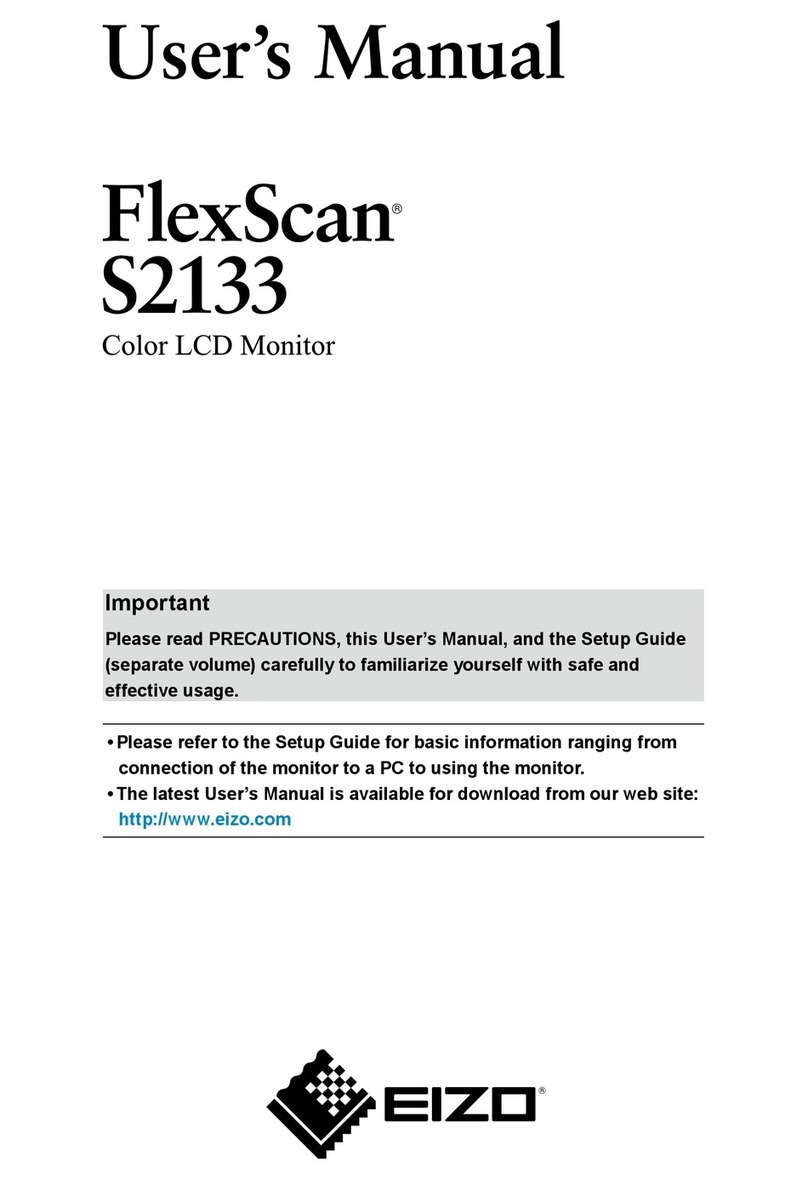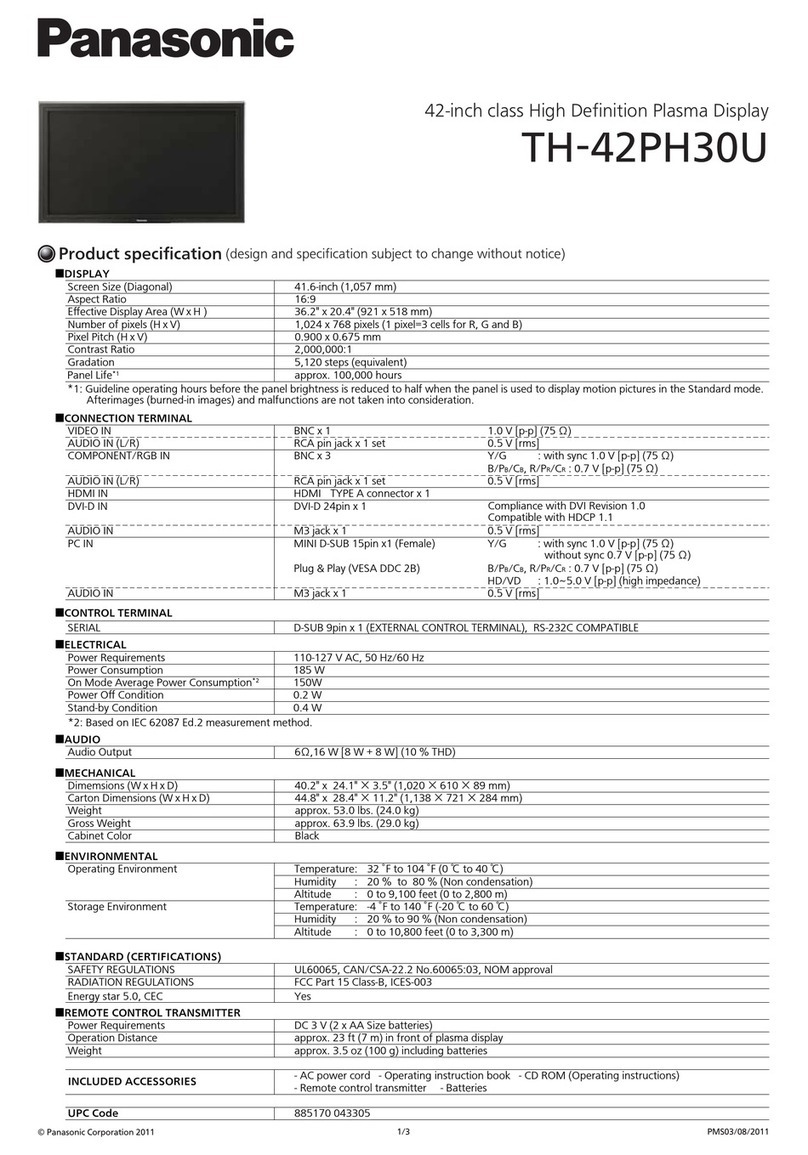ECKELMANN VDD 500 User manual

08.11.2022
Doku 1.1
Operating instruction
Temperature Display
Virtus Data Display

08.11.2022
2/23
Eckelmann AG
Business Unit Refrigeration and Building Automation
Berliner Straße 161
65205 Wiesbaden
Germany
Telephone +49 611 7103-700
Fax +49 611 7103-133
www.eckelmann.de
Board of Management:
Chairman Dipl.-Wi.-Ing. Philipp Eckelmann,
Dipl.Ing. (FH), Dipl.-Ing. (FH) Volker Kugel,
Dr.-Ing. Marco Münchhof
Supervisory Board: Hubertus G. Krossa
Deputy Chairman of the Supervisory Board: Dr.-Ing. Gerd Eckelmann
Seat of the company Wiesbaden, district court Wiesbaden HRB 12636
VAT ID: DE 113841021, WEEE Reg. No.: DE 12052799
Before commissioning and use, please check that this is the latest version of the document. With the
publication of a new version of the documentation, all previous versions lose their validity. The current operating
manual and information such as data sheets, more detailed documentation and FAQs are available for you on-
line in E°EDP (Eckelmann ° Electronic Documentation Platform) at
www.eckelmann.de/elds
You reach all relevant documents for this component directly using the QR code:
You reach all relevant documents for this component directly using the QR code:
https://edp.eckelmann.de/edp/lds/_gjjloM21s4
Information on safety and connection instructions are described in detail in chapter ”Industrialsafety notes”.
Copyright: All rights to any use whatever, utilisation, further development, forwarding and creation of copies
remain with the Eckelmann AG company. In particular, neither the contract partners of Eckelmann AG nor other
users have the right to distribute or market the IT programs/program parts or modified or edited versions
without express written permission. To some extent, names of products/goods or designations are protected for
the respective manufacturer (registered trademarks etc.); in any case, no guarantee is assumed for their free
availability/permission to use them. The information provided in the description is given independently of any
existing patent protection or other third-party rights.
Errors and technical modifications are expressly reserved.

08.11.2022
3/23
Table of Contents
1 Conventions.................................................................................................................................................4
1.1 Warning Signs and Symbols Employed....................................................................................................4
1.2 Explanation of 'Safety Instructions and Hazard Warnings'.....................................................................5
2 Safety instructions ......................................................................................................................................6
2.1 Disclaimer in the event of non-compliance ..............................................................................................7
2.2 Personnel requirements, requirements on staff ......................................................................................7
2.3 Intended Use................................................................................................................................................8
2.4 BGV A3 - Five safety rules..........................................................................................................................8
2.5 Electrostatic sensitive devices (ESDs) .....................................................................................................9
2.5.1 ESD - Rules for handling and working ..........................................................................................................9
2.6 Abbreviations used .....................................................................................................................................9
3 VDD 500 Functions....................................................................................................................................10
3.1 Comparison of VDD 500 versus BT 30 ....................................................................................................12
4 Installation and start-up VDD 500 ............................................................................................................14
4.1 Limitations UA 400 E / UA 401 E / UA 410 E............................................................................................16
5 Connection - Terminal assignment VDD 500 ..........................................................................................17
6 Decommissioning and Disposal ..............................................................................................................21
6.1 Außerbetriebnahme / Demontage............................................................................................................21
6.2 Disposal .....................................................................................................................................................21
7 Technical Data VDD 500............................................................................................................................22
8 Part numbers and accessories ................................................................................................................23

08.11.2022
4/23
•
•
•
•
•
1 Conventions
1.1 Warning Signs and Symbols Employed
Explanation of the warning signs, symbols and text formatting used in this operating and service manual:
DANGER
WARNING
CAUTION
*IfanyofthesesymbolsDANGER/WARNING/CAUTION is recognized, the user must refer to the operating
manual in order to understand the type of potential HAZARD and the required actions for avoiding the
HAZARD. Carefully observe all health and safety instructions and use particular caution in these situations.
Failure to observe the DANGER/WARNING/CAUTION symbols will cause injury (in the worst case,
severe injury or death) and/or damage to property!
ATTENTION
NOTICE
DANGER
Instructions with this symbol and/or the signal word DANGER warn the user of situations that will
cause severe injury or death if the specified instructions are not observed! *
WARNING
Instructions with this symbol and/or the signal word WARNING warn the user of situations that may
cause severe injury or death if the specified instructions are not observed! *
CAUTION
Instructions with this symbol and/or the signal word CAUTION warn the user of situations that may
cause moderate or minor injury if the specified instructions are not observed! *
ATTENTION
Instructions with this symbol and/or the signal word ATTENTION warn the user of situations that may
cause damage to property if the specified instructions are not observed! The ATTENTION symbol
highlights guidelines and regulations, instructions and proper working procedures that must be
particularly observed in order to prevent damage to and destruction of components or malfunctioning.
Failure to observe the ATTENTION symbol will cause damage to property!
NOTICE
Instructions with this symbol and/or the signal word NOTICE provide tips and useful additional
information.

08.11.2022
5/23
•
•
•
1.
2.
3.
4.
1.
2.
ELECTRIC SHOCK
Risk of fatal electric shock!
This symbol warns of danger from dangerous voltage with possible consequences such as severe injury and death. If this symbol
is seen, the user must refer to the operating manual in order to understand the type of potential HAZARD and the required actions
for avoiding the HAZARD. Carefully observe all health and safety instructions and use particular caution in these situations.
Failure to observe the WARNING symbol will cause injury (in the worst case, severe injury or death) and/or damage to
property!
ESD - Electrostatic-sensitive components and control components
DISPOSAL
Potential negative impact on people and the environment due to non-environmentally friendly disposal.
The strike-through dustbin symbol indicates the duty to dispose of items properly. Do not dispose of this product with other
domestic waste, see chapter Disposal. Please inform yourself about the local regulations for the separate disposal of electrical and
electronic products. The correct disposal of your old equipment protects people and the environment from possible negative
impact.
1.2 Explanation of 'Safety Instructions and Hazard Warnings'
Safety instructions or hazard warnings are composed of four elements:
Thesymbol with text (e.g. for DANGER),
a concise description of the hazard and
a description of the possible consequences.
Where applicable, a catalogue with measures for avoiding the hazard.
For example:
A general instruction consists of two elements:
Thesymbol with text (including NOTICE, if applicable) and
the text of the instruction:
For example:
Risk of destruction of the control component / controller!
Electronic components and control components (e.g. circuit boards) are sensitive to electrostatic charges. Circuit boards may only
be replaced when the power supply is disconnected. Always hold circuit boards by the edges. The guidelines for the handling of
electrostatic-sensitive components and control components must be observed at all times.
Failure to observe the ESD symbol will cause damage to property!
Failure to observe the DISPOSAL symbol will cause damage to people and the environment!
DANGER
Warning of dangerous electrical voltage! Risk of fatal electric shock!
Beware of external voltage at the digital inputs and outputs! Connections/plug connectors of the device
may only be plugged in, removed and/or wired when no voltage is present.
NOTICE
The current operating manual is available online from the E°EDP (Eckelmann ° Electronic
Documentation Platform) at www.eckelmann.de/elds.

08.11.2022
6/23
•
•
•
•
•
•
•
•
•
•
•
•
2 Safety instructions
This operating manual is part of the device. It must be kept in the vicinity of the controller as well as for future
use so that it can be consulted when required. The operating manual must be available to the operating and
maintenance personnel at all times in order to avoid operating errors. The safety regulations, instructions and
information must be strictly observed and complied with. During repairs on the entire E*LDS system, the
accident prevention regulations and general safety regulations must be strictly complied with. Important
information (safety instructions and hazard warnings) are indicated by appropriate symbols, see chapter
Conventions. Follow these instructions in order to prevent accidents and danger to life and limb, as well as
damage to the E*LDS system!
Always observe the following information:
Workontheelectricalsystemmayonlybeperformedbyauthorised, skilled personnel (accordingtothe
definition of skilled persons in DIN/VDE 0105 and IEC364) while observing the applicable
- VDE regulations
-Localsafetyregulations
-Intended Use
-FivesafetyrulesaccordingtoDGUVRegulation3
-ESDmeasures
-Operatingmanuals
For safety reasons, the equipment must not be used for any applications other than described in the
operating manual and only for the intended use.
Before using the device, check whether it is suitable for your application with regard to its limit values.
The equipment must be installed in an electrically shielded area within the switch cabinet.
Before connecting the device, it must be checked whether the power supply is suitable for the device.
Coded connectors must be used, as there is a possibility of plugging in non-coded connectors in such a
way that there is a danger to life and limb!
Specified ambient conditions (e.g. humidity and temperature limits, see chapter Technical Data) must be
observed and complied with at all times to prevent malfunction.
Before switching on the device, check the correct wiring of the connections.
The device must never be operated without its housing. If the intended use requires opening the housing,
the control unit must be disconnected from the power supply before opening the housing.
Note the maximum load of the relay contacts, see chapter Technical Data.
Note that all supply lines from and to the device, particularly those of the CAN bus and Modbus, must be
shielded or installed sufficiently far away from live cables. This prevents faulty measurements and protects
the device against electrical interference via the analogue inputs. Connection in parallel of RC elements is
recommended for applications with critical environment.
Contact the supplier in the case of any malfunction.
DANGER
Warning of dangerous electrical voltage! Danger of electric shock!
Beware of external voltage at the digital inputs and outputs! Connections/plug connectors of the device
may only be plugged in, removed and/or wired when no voltage is present.

08.11.2022
7/23
2.1 Disclaimer in the event of non-compliance
These operating instructions contain information on the commissioning, function, operation and maintenance
ofthecontrolsandoftheassociatedcomponents.
2.2 Personnel requirements, requirements on staff
Special technical knowledge is required for planning, programming, installation, putting into service and
maintenance work. This work may only be performed by skilled, specially trained personnel. The installation,
putting into service and maintenance personnel must have training that authorises them to perform
interventions in the system and the automation system. The planning and programming personnel must be
familiar with the safety concepts of automation technology. Working on electrical systems requires special
technical knowledge. Work on electrical systems may only be performed by instructed electrically skilled
persons or under the guidance or supervision of such persons. The applicable regulations (e.g. DIN EN 60204,
EN 50178, DGUV Regulation 3, DIN-VDE 0100/0113) must be observed. The operating personnel must be
instructed in how to handle the system / machine and the controller and must be familiar with the operating
instructions.
ATTENTION
Warning of damage to goods!
In our experience, the transmission of fault messages is not yet functional during the putting into
service (no internet connection, no telephone line installed, etc.). It is strongly recommended in such
cases to monitor the controller via the CAN bus using a system centre, a store computer or an operator
terminal and to enable the transmission of fault messages, for example using a GSM modem via a
mobile telephone system. In standalone operation, or as an alternative to monitoring via system
centre / store computer / operator terminal, an available alarm contact on the controller must be used
to enable the transmission of fault messages via a telephone network.
For more information, refer to E*LDS basics, safety instructions, CAN bus & Modbus.
Observance of these operating instructions is a prerequisite for safe and trouble-free operation.

08.11.2022
8/23
•
•
•
•
•
•
•
2.3 Intended Use
TheVDD500isdesignedforuseasatemperaturedisplayandforuseincommercialandindustrial
refrigeration facilities in accordance with the functional parameters and environmental conditions described in
the instruction manuals.
Read the safety instructions and the instructions for installation and putting into service, operation and
maintenance. THEN start the commissioning and/or operation of the machine / system.
The safety and functionality of the machine / system are only guaranteed for this
intended application. Never use the machine / system, its components, control
components or parts for any other purpose. The system must not be put into operation
until conformity with the applicable EU Directives has been established for the entire
system.
2.4 BGV A3 - Five safety rules
The following rules must be strictly observed!
1.Disconnect:The entire system to be worked on must be disconnected from the power supply at all poles.
2. Secure against reconnection: Attach information signs to the disconnected operating equipment stating:
What has been disconnected.
Reason for the disconnection.
Name of the person who made the disconnection.
Reconnection must be prevented using a suitable lock (e.g. padlock).
3. Prove dead (authorised skilled personnel only):
Check voltmeter just before use.
Prove dead on all poles at the disconnection point.
Prove dead on all poles at the work area.
4. Ground and short-circuit:Allelectricalpartsattheworkareamust be grounded and then short-
circuited.
5. Cover or block off adjacent live parts:Ifthereisliveequipmentadjacenttotheworkarea,itmustbe
covered using appropriate materials (e.g. insulation blankets / plates).
DANGER
Warning of dangerous electrical voltage! Warning of dangerous electrical voltage! Danger of
electric shock!
Beware of a possible external power supply! BEFORE connecting and disconnecting it must be
checked that no voltage is present at the controller! Connections/plug connectors of the device may
only be plugged in, removed and/or wired when no voltage is present.

08.11.2022
9/23
•
•
•
•
•
•
•
•
•
•
•
•
•
•
•
•
•
•
•
2.5 Electrostatic sensitive devices (ESDs)
All electrostatic-sensitive components and control components (referred to as "ESD" below) are labelled with
the warning sign shown. Electrostatic charges arise from friction of insulating materials (e.g. floor covering,
items of clothing made of synthetic fibres etc.). Even small charges can result in damage to or destruction of
components. Such damage is not always immediately noticeable; in some cases, it does not lead to failure until
after a certain operating time.
2.5.1 ESD - Rules for handling and working
Transport and store ESDs only in the protective packaging provided.
Avoid materials that may produce electrostatic discharge, for example
Plastic containers and table tops
Synthetic fibre clothing
Plastic-soled shoes
Plastic file covers
Styrofoam packaging
Computer monitors, etc.
Preferably wear the following:
Cotton work clothes
ESD shoes with conductive soles or leather soles
Use the following:
Conductive flooring
ESD workstations equipped with suitable tools (grounded soldering guns, antistatic wrist straps, etc.)
Conductive ESD bags, conductive plastic containers, IC tubes or cartons lined with conductive foam
Containers and worktops made of wood, metal or conductive plastics or paper bags
2.6 Abbreviations used
DGUV Regulation 3 - Accident Prevention Regulation for Electrical Systems and Equipment
(previously: BGV A3-Employer’sLiabilityAssociationRegulationforOccupationalHealthandSafety)
DINDeutschesInstitutfürNormunge.V.(GermanStandardisationInstitute)
E°EDP/EDP Electronic Documentation Platform of Eckelmann AG
ESDElectrostatic-SensitiveDevice
ESDElectro-staticdischarge(ElectroSensitiveDevices)
IECInternationalElectricCommittee
VDEVerbandderElektrotechnikElektronikInformationstechnike.V.(GermanAssociationforElectrical,
Electronic and Information Technologies)
ATTENTION
Risk of destruction of the control component / controller! Electronic components
and control components (e.g. circuit boards) are sensitive to electrostatic
charges.Therefore, the guidelines for handling electrostatic-sensitive components and
control components must be strictly observed.

08.11.2022
10/23
•
•
3 VDD 500 Functions
The white backlit LED temperature display VDD 500 (Virtus Data Display) has been developed for front
installation, e.g. in refrigerated case panels. The display shows the temperature of an assigned temperature
sensor from one of two temperature zones in the range between -50 °C..+100 °C and the current defrost/alarm
status.
Temperature Display VDD 500
Temperature and current status of the controller
Display of the current actual temperature of a temperature sensor: Only one of the temperature
sensors connected to the controller can be assigned to a temperature display.
The temperature sensor is assigned in menu 6-1 (only visible if DIP switch 7 is set to ON). A correction
value (parameter "Offset", menu 6-2-2) can be applied to the temperature values in the temperature
display in order to be able to compensate for differences between the thermometer in the refrigerated case
and on the display of the case controller.
Note: This correction value only concerns the display; the actually measured temperatures are not
corrected.Thecorrectionvaluehasnoinfluenceonthecontrol(cooling,defrostingetc.).
Defrost: The defrost status is indicated by a "d" (defrost) and always refers to the temperature zone in
which the assigned temperature sensor is located, e.g. 4.1.
Example: If the temperature sensor R4.1 has been assigned to the temperature display, the defrost status
refers to zone 1.
Alarm: For visualisation of a pending alarm, "AL" (alarm) can be displayed and then flashes at 2-second
intervals.
Using the parameter "Alarm symbol" (menu 6-2-2), the display of an alarm can be switched on or switched
off. The visualisation of the alarm status is switched off at the factory (parameter is set to "N").
Address of the temperature sensor
Continuous display
After switching on for the first time, the address (the last two digits of the serial number) of the
VDD is continuously displayed (e.g. "A09"). No temperature sensor has been assigned yet.
Display flashes at 2-second intervals
The VDD scan (menu 6-1) has been started and is running, the controller determines the number
of connected temperature sensors.
For full details and description of the VDD scan, addressing and assignment of temperature
sensors, see operating manual Case Controller UA 4xx E:

08.11.2022
11/23
•
•
•
•
Features and functions
Temperature display for front installation, e.g. in refrigerated case panels, with the same dimensions as the
temperature display BT 30.
White, clear 3-digit LED display, easy to read even in the dark.
Up to 4 temperature displays VDD 500 can be connected per case controller, e.g. for refrigerated case
elements / cold rooms.
No external power supply required, as power is supplied via the DISPLAY interface of the case controller.
Supported controllers
Case controllers UA 400 E / UA 401 E / UA 410 E
Example: 2 temperature displays VDD 500 per temperature zone, for details see chapter Connection -
Terminal Assignment VDD 500 Connection - Terminal assignment VDD 500
Limitations UA 400 E / UA 401 E / UA 410 E
- Up to max. 4 temperature displays can be connected to the DISPLAY interface.
- Max. 30 m cable length (longer distances on request).
-CannotbeusedsimultaneouslywithBT 300and/orBT 30 .
- The case controller and the connected VDD 500 can only be configured using a system centre connected on
the CAN bus.
For details, see chapter Limitations UA 400 E / UA 401 E / UA 410 E.
The temperature displays VDD 500 are only compatible with case controllers with 9-pole DIP switch
and version V3.20 or higher, the current firmware for the UA 4xx E is available in the EDP.
For further information, see chapter Installation and start-up VDD 500.

08.11.2022
12/23
3.1 Comparison of VDD 500 versus BT 30
VDD 500 BT 30 (for details, see operating manual BT 30 /
BT300)
Dimensions 62 x 29,4 mm, for details, see chapter Technical Data
VDD 500 Technical Data VDD 500
62 x 37 mm
Legibility in the dark Very good, as illuminated Difficult, as not illuminated
Assignment of
sensors
Free assignment of the sensors R2.1 / R4.1 / R2.2 / R4.2 Free assignment of the sensors R2.1 / R4.1 / R2.2 / R4.2
Protection rating
- front side
- connection side
(rear side)
IP40
IP00
IP65
IP65
Display /
presentation
Temperature / status via text:
-Defrost="d"
-Alarm="AL"
Temperature / status via intuitive symbols:
-Defrost="defrostsnowflake"
-Alarm="alarmsymbol"
Wiring
complexity
High! Each cable to each temperature display must be
stripped and connected individually:
Further wiring complexity:
- looping through the shield (E)
- mounting a terminating resistor at the end of the cable
(F)
- type of installation: Line structure
Simple! Each BT 30 has a shielded RJ45 connector with
7m connection cable:
Connect the RJ45 distributor to the DISPLAY interface of
the controller via the connection cable, plug in up to four
BT 30s, done
Tip: Optionally, a BT 300 can be used simultaneously on
the RJ45 distributor.
Further costs or the wiring:
-none
- Type of installation: Star structure
Connectivity Spring-loaded terminal without shield. According to the
standard, only one wire or two wires may be inserted, in
which case only with TWIN wire end sleeves.
Shielded RJ45 connector with 7 m connection cable,
Plug and Play
Polarity of the
spring-loaded
terminal
Attention: Deviating RS485 colour sequence compared
to the assignment established in the system (such as in
the Virtus-LINE):
VPC 5000 / Virtus 5: 1=Shield, 2=GND, 3=RS485-,
4=RS485+
VDD500:A1=+9V,A2=GND,B+=RS485+, A-=RS485-
Hard-wired RJ45 connector,
protection against polarity reversal

08.11.2022
13/23
VDD 500 BT 30 (for details, see operating manual BT 30 /
BT300)
Terminating
resistor
Yes, a 120 Ohm terminating resistor must be installed at
the end of the line (at the last temperature display).
No. Simply connect,
Plug and Play
Required
accessories
1x 6-pole COMBICON connector and
4x wire end sleeves
1x terminating resistor 120 Ohm
if necessary, 1x terminal block for looping through the
shield. Alternative: Cable ties
RJ45 distributor including connection cable 0.5 m
(KGLVERTBT1),
Plug and Play
Cable length Max. 30 m: 1..4x VDD 500
Note: BT 300 cannot be used simultaneously for system
reasons!
Max. 480 m: 1x BT 30 and 1x BT 300
Max. 210 m: 2x BT 30 and 1x BT 300
Max. 130 m: 3x BT 30, non BT 300
Max. 100 m: 4x BT 30, no BT 300
Configurability of
the temperature
display
Only via system centre (in the machine room) and CAN
bus, no standalone local configuration possible.
Even after the VDD scan (displays were found on the
Modbus), no subsequent assignment of sensors is
possible via BT 300, always only via the system
centre!
Via system centre and CAN bus, standalone local
configuration easily possible with BT 300.
Addressing and
preconfiguration
Only possible in connected state, must be connected to
controller, sensors can only be assigned via terminal
mode via the system centre.
Preconfiguration is not possible - only in connected
state (connection to case controller) in the system!
Coding is possible by cutting the wire loops.
A preconfiguration without current is possible at any
time,
e.g. by the switch cabinet builder.
Possible problems
with address
allocation/
VDD Scan
Possible address conflict!
But ONLY if the last two digits of the serial numbers are
identical. Installer must ensure that this constellation does
not occur.
None.
With the same coding of the wire bridges, e.g. of two BT
30, they show the same temperature.
Compatibility with
controllers
Only UA 4xx E with 9-pole DIP switch and Version
V3.20 or higher
All controller types from UA 300 x to UA 400 x are
supported.

08.11.2022
14/23
1.
2.
3.
4.
5.
6.
4 Installation and start-up VDD 500
Case controller UA 4xx E commissioning
Switch off controller, disconnect from the power supply (A).
Activate DISPLAY interface for the communication with VDD 500:
Set DIP switch 7 to ON (B).
Connect temperature displays VDD 500 to the DISPLAY interface (C),
for details about the wiring, see chapter Connection - Terminal assignment VDD 500.
Switch on the controller again, supply with power (A).
All temperature displays VDD 500 connected to the case controller display their address (e.g. "A09")
continuously, as no temperature sensors have been assigned to them yet.
Note: The displayed address corresponds to the last two digits of the serial number of the respective
temperature display.
IntegratetemperaturedisplaysVDD500:
- first call up the terminal mode of the desired case controller via the system centre (E) connected via the
CAN bus (D),
- start the search via the "VDD scan" parameter in menu 6-1 and determine the number of connected
temperature displays.
Note:
The VDD Scan parameter is only visible if DIP switch 7 is set to ON!
- The addresses (e.g. "A09") flash in the display during the VDD scan.
DANGER
Warning about dangerous electrical voltage!
Danger to life - Danger of electric shock! BEFORE connecting and disconnecting, it must be
checked that no voltage is present at all connections of the controller.
The temperature displays VDD 500 are only compatible with case controllers with 9-pole DIP switch
(B) and version V3.20 or higher, the current firmware for the UA 4xx E is available in the EDP. The
temperature displays VDD 500 can only be configured using a system centre (E) connected on the
CAN bus!

08.11.2022
15/23
7. After the "VDD Scan", the temperature sensors of the case controller can now be assigned to the connected
temperaturedisplaysVDD500.
Practical tip: In practice, two temperature displays - one for each temperature zone - are usually used to
display the return air temperatures R4.1 and R4.2 (F). If required, two additional temperature displays can
be installed for the display, for example, of the two return air temperatures R2.1 and R2.2 (G).
•
•
Brief information for the configuration
Attention! Temperature displays with the same two digits at the end of their serial number must
not be connected at the same time to a case controller, as they can no longer be uniquely identified
during / after a VDD scan and this will cause problems!
During the VDD scan (menu 6-1), the addresses 1..100 are automatically queried for max. 4
temperature displays. The temperature displays respond to the query according to the last two
digits of their serial number (SN) and are registered in the controller. If the last two digits of the
serial number are "00", then this corresponds to the address "100".
If 2 temperature displays have been connected and addresses 09 and 28, for example, have
been found via VDD Scan, the VDD scan is not terminated until after reaching address 100 -
i.e. not until all possible addresses have been queried - max. duration approx. 2 minutes.
The address of the temperature display is shown during the VDD scan.
If 4 temperature displays have been connected and addresses 03, 09, 28 and 32, for
example, have been found via VDD Scan, then the VDD scan will be automatically
terminated after the fourth device found, as all 4 possible temperature displays have been
found.
After the initial scan, the return air sensor R4.1 (terminals Z21/Z22) is automatically assigned to all
temperature displays. Afterwards, sensors can be assigned to the determined temperature
displays. For full details and description of the VDD scan, automatic addressing and assignment of
temperature sensors, see operating manual Case Controller UA 4xx E:

08.11.2022
16/23
•
•
•
•
1.
2.
3.
4.
5.
6.
7.
4.1 Limitations UA 400 E / UA 401 E / UA 410 E
Up to max. 4 temperature displays can be connected to the DISPLAY interface.
Max. 30 m cable length (longer distances on request).
CannotbeusedsimultaneouslywithBT300and/orBT30.
The case controller and the connected VDD 500 can only be configured using a system centre connected
on the CAN bus.
Practical tip:
Configuration of a case controller UA 4xx E with an operator interface BT 300 - if necessary, connection of
BT30
Procedure
Disconnect power supply from the controller (A).
DetachtheconnectorsforthetemperaturedisplaysVDD500fromthecontroller(B).
Activate DISPLAY interface for the communication with BT 300:
Set DIP switch 7 to OFF (C).
ConnectoperatorinterfaceBT300(ifnecessaryBT30)totheDISPLAYinterface(D),
for details, see operating manual Operating Manual BT 300.
Connect controller to the power supply again (A).
TheBT300cannowbeusedtooperateandconfigurethecontroller.
Note:TheparametersfortheVDDscanandforconfigurationofthetemperaturedisplayVDD500arenow
hidden in menu 6-1 as the DIP switch 7 is set to OFF!
Iftheconfigurationhasbeencompleted,theoperatorinterfaceBT300isnolongerneeded:
Disconnectthepowersupplyfromthecontroller(A),disconnecttheoperatorinterfaceBT300fromthe
DISPLAY interface (D),
reactivatetheDISPLAYinterfacefortemperaturedisplaysVDD500(C)-setDIPswitch7toON-and
reconnect the connector for the VDD 500 (B).
Connect controller to the power supply again (A).

08.11.2022
17/23
•
•
•
•
•
•
•
•
•
5 Connection - Terminal assignment VDD 500
Connection instructions for case controllers UA 400 E / UA 401 E / UA 410 E
The DISPLAY interface must first be activated on the case controller for communication with temperature
displaysofthetypeVDD500:
Set DIP switch 7 to ON (A), for details, see chapter Installation and start-up VDD 500.
The 6-pole mating connector (B) on the DISPLAY interface of the case controller is used for power supply
and communication to the max. 4 temperature displays VDD 500.
The recommended cable type is LiYCY 2x2x0.25 mm² or J-Y(ST)Y 2x2x0.8 mm.
The shield (SHLD) of the cable must be connected on one side to a PE terminal (C) near the DISPLAY
interface of the controller.
The cable is connected via the 4-pole spring-loaded terminal (D) on the rear of the temperature display VDD
500 using TWIN wire end sleeves.
Looping through the shield: at each terminal point, the shield ends of the cables must be connected to each
other as short as possible (E).
The individual temperature displays VDD 500 must be connected to each other in a line structure, spur
lines (star) are not permitted!
At the last temperature display VDD 500 (F) or at the end of the cable, a terminating resistor of 120 Ohm*
must be connected between terminals A- and B+ using TWIN wire end sleeves, the shield remains in the
cable.
The maximum cable length - from the beginning of the 6-pole mating connector to the last temperature
display VDD 500 - must not exceed 30 m.
DANGER
Warning about dangerous electrical voltage!
Danger to life - Danger of electric shock! BEFORE connecting and disconnecting, it must be
checked that no voltage is present at all connections of the controller.
ATTENTION
All supply lines for the temperature display VDD 500 must be shielded (cable type: LiYCY 2x2x0.25
mm² or J-Y(ST)Y 2x2x0.8 mm)! For details about the supply lines, see the topic "Modbus" in the
operating manual "E*LDS Basics, Safety Instructions, CAN Bus & Modbus".

08.11.2022
18/23
Connection assignment
Terminal assignment
UA 4xx E VDD 500 Wire colour Function
1
2
3
6
4/5
A1
A-
B+
A2
--
yellow
brown*
white*
green
--
Supply / +9 V DC
A (-) / RS485 (-)*
B (+) / RS485 (+)*
GND (Ground)
Not used
•
•
•
*Specialfeature:
The assignment and colour sequence of the connector pin assignment of the temperature display
VDD 500 is different from that of the system centres Virtus 5 / CI 5xx0 / CI 4xx0 / and the pack
controller VPC 5000.
* A 120 Ohm terminating resistor is permanently integrated in the case controller between terminals
2and 3. This means that the DISPLAY interface represents the beginning of the line, termination at
these terminals must not be done!
It is only at the end of the line (at the last temperature display VDD 500) that a terminating
resistor of 120 Ohm must be installed.
Mounting instructions Insert one end of the 120 Ohm terminating resistor and one wire (A-
brown / B+ white) with the enclosed TWIN wire end sleeve.

08.11.2022
19/23
•
•
•
Examples for connection of VDD 500 to UA 4xx E
Variant 1: Case controller UA 400 E / UA 410 E
Two temperature zones - Standard
One temperature display per zone, e.g. for return air (R4.1/R4.2)
Variant 2: Case controller UA 400 E / UA 410 E
Two temperature zones - maximum number of VDD 500
Two temperature displays per zone, e.g. for return air (R4.1/R4.2) and supply air (R2.1/R2.2)
Variant 3: Case controller with only one temperature zone, e.g. UA 401 E
One temperature display, e.g. for return air (R4.1)
For full details and description of the VDD scan, automatic addressing and assignment of temperature
sensors, see operating manual Case Controller UA 4xx E:

08.11.2022
20/23
Practical tip / recommendation:
If the temperature displays VDD 500 are already installed in a refrigerated case at the factory, two 4-pole
terminal blocks should be provided there to loop through the cabling for easier connection:
A: The cabling comes from the DISPLAY interface of the case controller or from another temperature display
VDD 500.
B: The cabling (B) goes to the next temperature display or
C: the cabling ends here so that the necessary 120 Ohm terminating resistor can be connected to this terminal
block.
Table of contents
